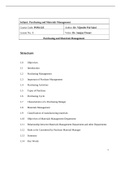Subject: Purchasing and Materials Management
Course Code: POM-325 Author: Dr. Vijender Pal Saini
Lesson No.: 1 Vetter: Dr. Sanjay Tiwari
Purchasing and Materials Management
Structure
1.0 Objectives
1.1 Introduction
1.2 Purchasing Management
1.3 Important of Purchase Management
1.4 Purchasing Activities
1.5 Types of Purchase
1.6 Purchasing Cycle
1.7 Characteristics of a Purchasing Manger
1.8 Materials Management
1.9 Classification of manufacturing materials
1.10 Objectives of Materials Management Department
1.11 Relationship between Materials Management Department and other Departments
1.12 Risks to be Considered by Purchase Material Manager
1.13 Summary
1.14 Key Words
1
,1.15 Self-assessment questions
1.16 References/Suggested readings
1.0 Objectives
After going through this lesson, you will be able to:
Understand the concept of Purchasing and Materials Management.
Identify purchasing activities and know the importance of purchase
management.
Describe the concept of Materials Management and explain the relationship
between Materials Management Department and other Departments
1.1 Introduction
Purchasing
Purchasing describes the process of buying. It is the learning of the requirement,
identifying and selecting a supplier, negotiation price. Purchasing is an element of the
wider function of procurement and it includes many activities such as ordering, expediting,
receipt and payment. Purchasing is responsible for obtaining the materials, parts, supplies
and services needed to produce of a product or provide a service. (Joyce, 2006) Purchasing
can be divided into two broad categories, large and small purchases, based on seven
characteristics of purchased product – volume, specificity, technological complexity,
essentiality, fragility, variability, and economic value. (Parikh, 2005)
Bulk Purchase
2
,In case of bulk purchases there are high volume items, large amount, and more frequent
utilization with more specific use. Bulk purchases are handled in large organisations and
multinational organisations with the standardized purchasing process, where as some other
organizations use separate purchasing process. There are frequent misuse and lack of
control in purchasing process in those organizations in which same standardized process is
used for both bulk and small purchasing. Large purchases are typically non-urgent in
nature. Large-volume, continuous-usage items can be covered by blanket purchase orders,
which often involve annual negotiation of prices.
Small Purchase
In case of small purchase there are low volume items, small amount, less frequency of
utilization, high variety and low technical complexity. Mainly small purchases include
machine parts, auto parts, machine repairs, in frequent sullies of offices and miscellaneous
goods. Small purchases are urgent in nature.
There are two basic types of purchasing in the business world: purchasing for resale or
purchasing for consumption or conversion. (Dobler, 1984) Purchasing for resale or resale
purchasing is mainly performed by retailers and wholesalers (called merchants).
Purchasing for internal consumption or conversion is called industrial buying. The
industrial buyers generally face different and complex problems with comparisons of
merchandise buyers or resellers. For instance, the industrial buyers have to spend time to
anticipate in determining what products should be produced or manufactured and what
product should be purchased from outside or suppliers. They also correlate their purchasing
3
, with sale forecasts and production schedules. In some books, you will find the terms like
purchasing, procurement, supply chain, materials management, supply material and
logistics interchangeably. But there is a hair-line difference in all these terms.
Important Terms
Purchasing
Purchasing describes the process of buying. It covers the knowledge of the requirements,
identifying and selecting a supplier and negotiating price
Procurement
It is a broader term. It includes purchasing products required for production, stores, traffic,
receiving, inspection and salvage.
Materials Management
It includes planning, organising, communicating, directing and controlling of all those
activities mainly concerned with the flow of materials into an organisation. Material
management views material flows as a system.
Logistics Management
It is the planning and controlling of the flow of raw material in a cost effective manner
from the suppliers or point of origin to the manufacturing and then flow of finished goods
for consumption in the customers’ hands.
4




